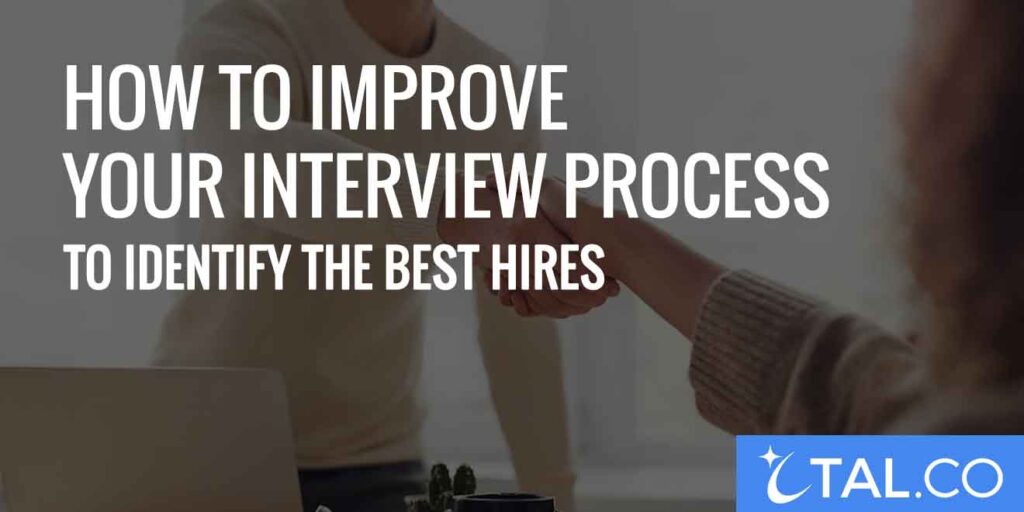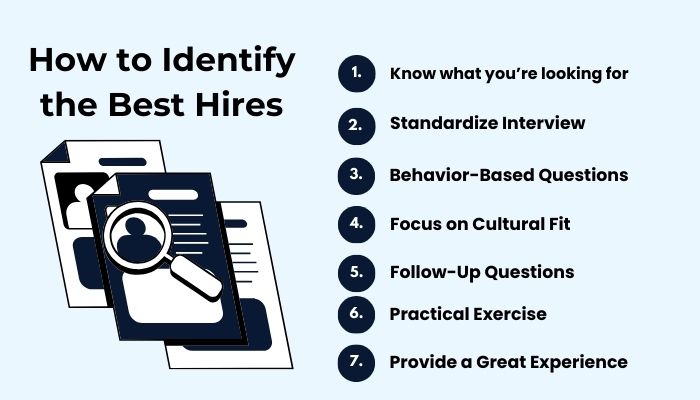
How To Improve Your Interview Process to Identify the Best Hires
If you’ve ever hired someone who looked amazing on paper but didn’t quite live up to the résumé after they started, you’re not alone. Interviewing can feel like simulating real-life constraints in a short conversation—and sometimes you don’t walk away with the full picture of a candidate’s potential.
But that doesn’t mean identifying top talent has to be a gamble. With a few strategic tweaks to your interview process, you can weed out the fluff and zero in on the best hires for your organization.
Outline
Provide a Great Candidate Experience

Know Exactly What You’re Looking For
Before you post that job opening or schedule a round of interviews, make sure you have absolute clarity on the role’s key requirements. Sit down with the team the new hire will be joining and talk through your expectations, the ideal background, and any soft skills that would complement your existing group.
The more you understand what “great” looks like, the better you can sort through résumés and structure your interview questions.
Standardize—But Stay Flexible
Believe it or not, having at least a partially standardized interview script can be a game-changer. By asking all candidates the same baseline questions, you can compare apples to apples and avoid letting personal biases creep in. That said, leave yourself room to follow up on interesting points or ask for clarification when needed.
If a candidate sparks your curiosity about a project on their résumé, dive deeper. Just be sure your key questions remain the same so you don’t unwittingly give one person an easier path than others.
Ask Behavior-Based Questions
Anyone can say they’re “detail-oriented” or “team-focused,” but it’s through real-world examples that these qualities shine (or not). Instead of asking, “Are you comfortable working in a team environment?” you might say, “Tell me about a time you collaborated on a challenging project—how did you manage differing opinions?”
This helps you glimpse how candidates apply their skills under pressure and whether they can navigate the kinds of issues they’ll actually face on the job.
Focus on Cultural Fit and Alignment
Culture is more than just a buzzword; it can make or break a new hire’s success. If your workplace thrives on collaboration, a lone-wolf mindset might clash. If your culture is based on independence and initiative, too much reliance on group dynamics could slow everything down.
During the interview, ask questions that focus on shared values—how they handle conflict, how they give or receive feedback—so you can see if their approach meshes with your team’s ethos.
Dig Beneath the Surface With Follow-Up Questions
Good interviews are conversations. If a candidate mentions revamping a process and saving their old company thousands of dollars, ask for the details. What exactly did they change? Who else was involved?
Did they encounter any obstacles along the way? These deeper questions can reveal how candidates actually moved the needle and whether they took initiative or just hopped on a co-worker’s success story.
Give Candidates a Small “Taste Test”
If possible, consider adding a practical exercise relevant to the role—like a short case study, a coding test, or a task demonstration. This doesn’t need to be exhaustive or time-consuming, but it will show you how a candidate thinks in real time. For the candidate, it also offers a window into what the job will be like on a day-to-day basis.
Provide a Great Candidate Experience
Remember, as much as you’re interviewing them, they’re also sizing you up. Make the process smooth, communicate your timelines clearly, and give constructive feedback when you can. Even if you don’t extend an offer, a friendly experience can pay off in goodwill—and potentially lead to referrals or positive word-of-mouth recommendations for your company.
Hiring is as much about process as it is about intuition. Combine clarity on what you need, consistent and structured questioning, and multiple viewpoints to ensure you don’t overlook the right person. With a well-thought-out approach, you’ll have fewer surprises after the new hire starts—and a stronger, more harmonious team in the long run.

